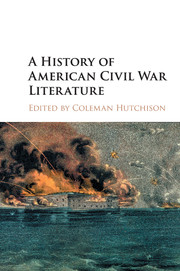Book contents
- Frontmatter
- Dedication
- Contents
- List of Illustrations
- Notes on Contributors
- Preface
- Acknowledgments
- Part I Contexts
- Part II Genres
- Part III Figures
- 12 Walt Whitman
- 13 War and the Art of Writing: Emily Dickinson's Relational Aesthetics
- 14 Herman Melville and the Civilian Author
- 15 Looking at Lincoln
- 16 Frederick Douglass, Violence, and Abraham Lincoln
- 17 Mary Boykin Chesnut: Epic and Miniature
- 18 Mark Twain
- 19 Replay: William Faulkner and the Civil War
- 20 Robert Penn Warren's Civil War
- 21 Natasha Trethewey's Civil War
- 22 Afterword: Archiving the War
- Recommendations for Further Reading
- Index
17 - Mary Boykin Chesnut: Epic and Miniature
from Part III - Figures
Published online by Cambridge University Press: 05 December 2015
- Frontmatter
- Dedication
- Contents
- List of Illustrations
- Notes on Contributors
- Preface
- Acknowledgments
- Part I Contexts
- Part II Genres
- Part III Figures
- 12 Walt Whitman
- 13 War and the Art of Writing: Emily Dickinson's Relational Aesthetics
- 14 Herman Melville and the Civilian Author
- 15 Looking at Lincoln
- 16 Frederick Douglass, Violence, and Abraham Lincoln
- 17 Mary Boykin Chesnut: Epic and Miniature
- 18 Mark Twain
- 19 Replay: William Faulkner and the Civil War
- 20 Robert Penn Warren's Civil War
- 21 Natasha Trethewey's Civil War
- 22 Afterword: Archiving the War
- Recommendations for Further Reading
- Index
Summary
In March 1864, Southern intellectual and Civil War saloniste Mary Boykin Chesnut attended a Richmond prisoner exchange, joined by Confederate President Jefferson Davis and exiled Irish nationalist John Mitchel. After Davis addressed the assembled crowd, Chesnut spotted another group of Southern luminaries: “the Lees were all there – stood in a group in full fig [sic] – Custis, Rooney, Robert, Chapman Leigh, Mary Agnes, Mildred. Custis will be gazetted in a few days major general and put in command of Richmond.” The appearance of the general's extensive family, men in uniform, and women passionately dedicated to the Confederate cause rallied Chesnut's spirits. Turning her gaze on the redeemed captives, she found shattered-looking men who appeared “as if they had been dead to this world for years.” The contrast could not have been more striking: Chesnut identified Lee and his soldier sons as quasi-Olympic gods, while across the field, she registered their antitypes, ruined shells dragged back from the underworld. In her revised 1880s account of this seminal 1864 moment, Chesnut had inserted herself into the epic tradition.
Mary Boykin Chesnut drafted and revised the most encyclopedic and searching Civil War narrative in American letters. Yet 130-plus years after she left it unfinished at her death, the book continues to be misunderstood as a primary-source artifact, mistaken for a massive journal rather than acknowledged as a self-conscious work of art cast in diary form. I begin this essay by untangling the complicated textual history of Chesnut's revised narrative. In what was the era of realism, she had deployed a fragmented form that went unrecognized by her first editors, who “smoothed” her prose into traditional paragraphs and pages. Chesnut crafted her revised Civil War epic from thousands of what she called “scraps,” both short and occasionally longer bursts of battlefield reports, home-front observations, anecdotes concerning her elite Confederate social circle, and personal commentary about family members and beloved friends. Recognizing the narrative virtuosity abiding in these smaller and larger shards, distinguished Southern historian Michael O'Brien has gestured toward the idea that Chesnut is a modernist writer avant le lettre.
On the vast frame of the epic, Chesnut built her revised narrative from miniatures. With lapidary care, she set anecdote against observation, dramatic scene beside factual assertion.
- Type
- Chapter
- Information
- A History of American Civil War Literature , pp. 257 - 271Publisher: Cambridge University PressPrint publication year: 2015



